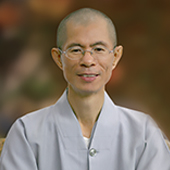“Namo Amituofo” Equals the Three Repositories and Twelve Divisions
There is a saying: “The Buddha has spoken all the good words in the world, and the Sangha has populated most of the famous mountains in the world.” The so-called “good words in the world” are not flattery or small talk. Buddha’s words are words of truth, virtue, and compassion, and Shakyamuni Buddha has said it all. This saying has aptly described Amituofo’s name, a name of extraordinary, boundless, inconceivable, and profound merits. A name with the deepest hidden meaning.
The six-character name “Namo Amituofo” is equivalent to the Tripitaka (Three Repositories) and the Twelve Divisions of all Buddhist scriptures. The purpose of all these scriptures is to explain clearly the merits of the name of Amitabha Buddha. Merits which are infinite, inconceivable, and profound. Merits which are sublime and with unsurpassed benefits. Therefore, if we undertake an in-depth study of the Tripitaka and the Twelve Divisions, we will naturally seek refuge and rely entirely on “Namo Amituofo.”
The Three Jewels of the Buddha, the Dharma, and the Sangha is the foundation of Buddhism. Among the Sangha, the highest level of cultivation attained is the stage of Bodhisattva of Equal Enlightenment, one birth away from Buddhahood. The most famous Bodhisattvas at this level are Manjusri and Samantabhadra. Even at this advanced level of cultivation, their aspiration is none other than rebirth in the Land of Ultimate Bliss.
Manjusri and Samantabhadra Bodhisattvas are the most venerable Bodhisattvas to us ordinary beings. But what are they like before Amituofo? They appear to be the most modest, humble, and respectful, like the lowest-level and the lowest-birth mortals. This is how the scripture describes their aspirations:
I vow that when my life approaches its end,
all obstructions will be swept away;
I shall see Amituofo and
Be born in His Land of Ultimate Bliss.
Their desire to have their karmic obstacles removed is no less than that of the lowest-level and the lowest-birth mortals.
Therefore, the more comprehensively we study the Tripitaka, the deeper our wisdom becomes. With that wisdom, we gain a better understanding of the immeasurable, inconceivable and profound merits of the Buddha’s name. Our respect and praise for the six-character name “Namo Amituofo” just grows more and more.
(Translated by the Pure Land School Translation Team;
edited by Householder Fojin)
Guiding Principles
Faith in, and acceptance of, Amitabha’s deliverance
Single-minded recitation of Amitabha’s name
Aspiration to rebirth in Amitabha’s Pure Land
Comprehensive deliverance of all sentient beings


